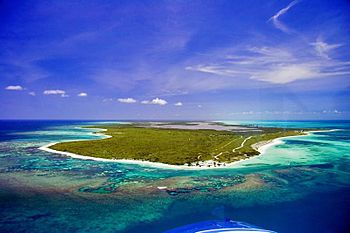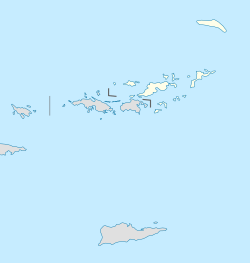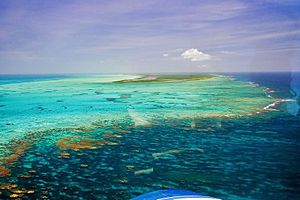Anegada facts for kids

Unlike the other British Virgin Islands, Anegada is a low-lying coral island rather than a volcanic island
|
|
|
The location of Anegada within the British Virgin Islands
|
|
| Geography | |
|---|---|
| Location | Atlantic Ocean |
| Coordinates | 18°44′N 64°20′W / 18.733°N 64.333°W |
| Archipelago | Virgin Islands |
| Area | 14 sq mi (36 km2) |
| Administration | |
| British Overseas Territory | British Virgin Islands |
| Demographics | |
| Population | 285 |
| Additional information | |
| Time zone | |
| ISO code | VG |
|
|
|
Anegada is the most northern island in the British Virgin Islands (BVI). This group of islands is part of the larger Virgin Islands chain. Anegada is about 24 kilometers (15 miles) north of Virgin Gorda.
Unlike most islands in the BVI, Anegada is made of coral and limestone. It's not from volcanoes. While other islands are mountainous, Anegada is very flat and low. Its highest point is only about 8.5 meters (28 feet) above the sea. This is why it's called Anegada, which means "flooded land" in Spanish.
Anegada is about 38 square kilometers (15 square miles) in size. This makes it the second largest of the British Virgin Islands. However, it has the fewest people among the main islands. In 2010, only 285 people lived there. Most of them live in the only village, called The Settlement.
From 2008 to 2013, Anegada had one of the tallest Christmas trees in the Caribbean. Each year, there was a special tree lighting ceremony and party. This tree helped bring more visitors and sailors to the island.
Contents
What People Do on Anegada
The main activity on Anegada is tourism. During the busy tourist season, about 200 extra visitors come to the island each day.
Commercial fishing is also very important. Local fishermen catch most of the fresh fish and lobster for all the British Virgin Islands. Anegada is also a great place for fly fishing. Its long, flat southern shores are home to many bonefish.
How to Get to Anegada
You can reach Anegada by flying into the small Auguste George Airport (NGD). There are also ferries that run three times a week. Many people also come by private boat.
You can take charter flights directly to Anegada from Tortola and Virgin Gorda in the BVI. Flights also come from places like San Juan, St. Thomas, Antigua, and St. Maarten.
Exploring Horseshoe Reef
Anegada is famous for its long, white sand beaches. It's also known for the 29-kilometer (18-mile) long Horseshoe Reef. This is one of the biggest barrier coral reefs in the Caribbean.
The reef makes it tricky to sail to Anegada. Many boat rental companies don't let their customers sail there. This is to prevent boats from getting stuck on the reef.
Over the years, the reef has caused hundreds of shipwrecks. Some famous shipwrecks include HMS Astraea in 1808 and the MS Rocus in 1929. Because of this, Anegada was once a popular spot for scuba diving. To protect the reef, the BVI government has made it against the law to anchor on Horseshoe Reef.
Amazing Animals of Anegada
Anegada has large salt ponds on its west side. These ponds are home to special animals. They were named a Ramsar Site in 1999.
In the 1830s, thousands of Caribbean flamingos lived in these ponds. But people hunted them for food and feathers. By 1950, they had disappeared. Luckily, flamingos have been brought back to the island. In 2016, there were about 200 flamingos. These birds are another reason tourists visit. Officials try to limit visitors to the flamingo areas so the birds can live peacefully. The western salt ponds and southeastern coastal mangroves are also recognized as an Important Bird Area.
Other rare animals on Anegada include the Anegada rock iguana (Cyclura pinguis). Several types of turtles also live here. You can find conch, Caribbean lobster, and many kinds of fish near Anegada. They are especially found in the deep waters north of the island.
The Fort Worth Zoo helps protect the Anegada Rock Iguana. They have a "Headstart" program in The Settlement. Baby iguanas are collected and raised until they are big enough to protect themselves. This helps them against feral cats, which are their only predators on Anegada. By 2016, over 200 iguanas had been released back into the wild. There's even an annual Iguana Festival to celebrate this special island animal.
The reef near The Settlement used to have many conch. But too much fishing caused the conch population to disappear there. When visitors arrive at The Settlement, they often see huge piles of empty conch shells on the shore.
You can also find wild cattle, donkeys, goats, and sheep living all over the island.
Hurricanes and the Island
People on Anegada have always known how to deal with hurricanes. In the past, they would tie their small boats to mangrove trees and cover them with tarps. Today, if there's enough warning, most people stay on the island. They don't usually leave for Tortola until after the storm has passed.
On August 30, 2010, the eye of Hurricane Earl passed very close to Anegada. It was a strong Category 4 hurricane. This caused a lot of damage on the island. The south side had major flooding from the storm surge and big waves. The north side was protected by Horseshoe Reef and didn't have a storm surge or breaking waves. Even though the hurricane was very strong, no one on the island was seriously hurt.
Learning on Anegada
About 70 students go to school at the Claudia Creque Educational Centre. This school used to be called Anegada Primary and Secondary School. It's the only school on Anegada. It teaches students from pre-school all the way through high school. The British Virgin Islands government pays for and runs the school.
Images for kids
See also
 In Spanish: Anegada para niños
In Spanish: Anegada para niños






